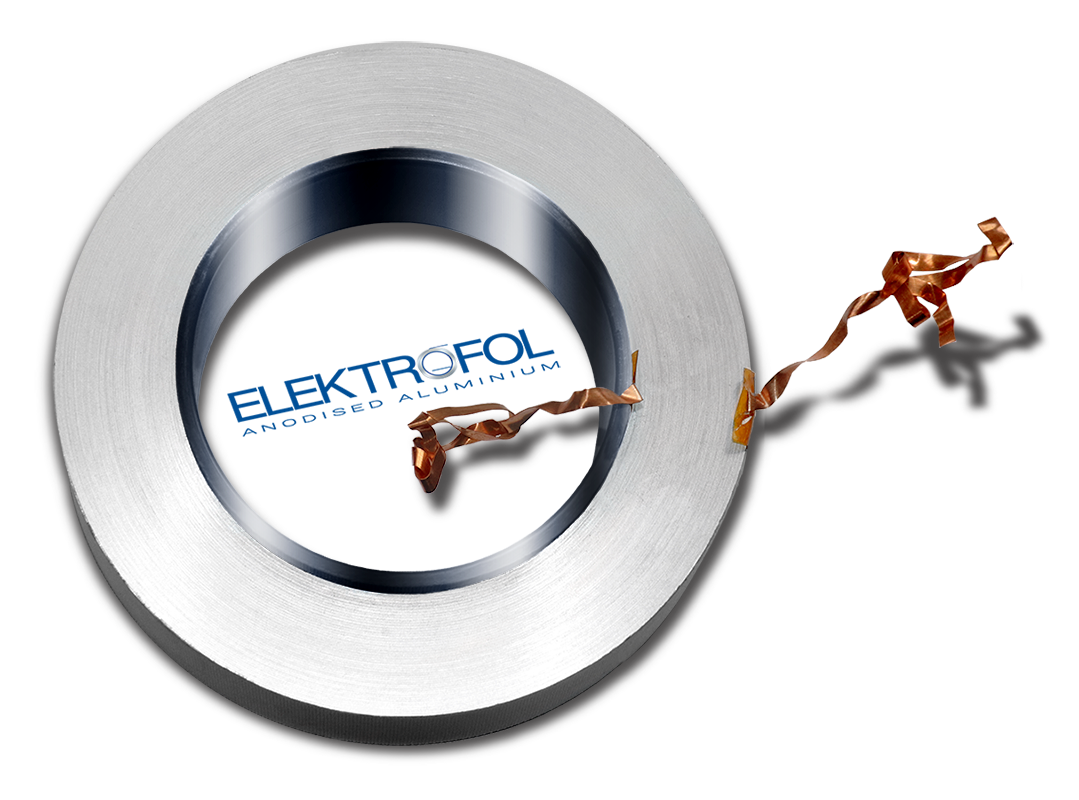ANODISED ALUMINIUM COIL
- Home
- /
- Anodised Aluminum Coil
Elektrofol
ELEKTROFOL MAGNET COIL
Technical Advantages
Superior Heat Dissipation
Coils made of Anodised Aluminium Strip dissipate heat much faster since every single turn is itself part of the heat emitting exterior surface. In a conventional fibreglass or nomex covered and varnished wire coil, the dissipation of heat from the Coil centre is significantly obstructed. The poor thermal conductivity of the inter-turn insulation as well as air inclusions results in heat build-up that may ultimately destroy the Coil. Particularly in Oil Cooled Electromagnet Coils wound with Anodised Aluminium Strip, every single coil turn is directly exposed to oil cooling. On the other hand, in Wire Wound Coils, inside turns do not come into contact with the Oil. Hence the cooling is uneven, resulting in hot spots within the inner layers of the coil.
Lower Operating Temperature
The thermal conductivity and heat emission capacity of the oxide insulating layer are far superior to that of wire covered with conventional insulating material. As a result, a Coil made from Anodised Aluminium Strip builds up much less heat under load. The cooler Coil will have a longer life and superior magnet power.
No inter-turn Insulation needed - Superior Space Factor
The space factor for a coil made with Anodised Aluminum Strip is 0.85 or higher where as that for conventional fibreglass or nomex insulated coils is in the range of 0.5-0.65. This is because the individual turns of an Anodised Aluminium Strip Coil are firmly in contact with each other and there are virtually no air filled interspaces. As the interlayer voltage is equal to the inter-turn voltage, there is no need for interlayer insulation as required in wire coils. Such insulation layers are significantly thicker. For example, the Aluminium Oxide layer is typically 1- 6 microns. So it is much thinner than fibreglass covering which is around 220 microns.
Ideal for High Temperature Service
As the Aluminium Oxide Insulation layer will not melt below 2000oC and Aluminium has a melting point of 658oC, Anodised Aluminium Coils can survive temperatures of up to 500oC for extended duration. By contrast conventionally insulated Aluminium or Copper Wires have a maximum temperature limitation of 180oC – 220oC if Class ‘H’ or Class ‘C’ insulating materials are used.
Typically, in Lifting Magnet applications a Coil made of Anodised Aluminium has a far better chance of survival in the following possible circumstances.
i. If rated duty cycle of 60%/10 min or 75%/10 min is exceeded repeatedly.
ii. When continuously handling hot materials such as Billets at 600oC temperature in concast plants.
iii. If Magnet is accidentally left “ON” continuously for a few hours.
iv. If used occasionally for Direct Furnace Charging.
Quality Assurance
The ELEKTROFOL Anodising Line is equipped with state-of-the-art equipment and trained manpower to ensure quality check at all stages, from incoming raw materials to finished product. Test Equipment includes all necessary Mechanical, Electrical and Chemical testing instrumentation. Tests include Dimensional checks, Conductivity measurement, Resistance measurement, Film Coating Thickness measurement, Breakdown Voltage Tests, Chemical Analysis to ensure consistency of Anodising and other Baths, etc.
Coil Winding Expertise
The Magnet Coils are wound on special purpose Coil Winding Machines imported from Germany. Coil jointing and Flexible Copper Lead terminations are carried out using state-of-the-art Cold pressure joining, Ultrasonic welding Machines and Techniques acquired from Germany.
Summary Of Advantages Of Elektrofol
- Highest space factor allows compact construction.
- Highest heat dissipation.
- Lower temperature rise.
- Light weight.
- Highest thermal stability due to excellent heat transfer of ELEKTROFOL Coils.
- Lower hot spots.
- Lower operating temperature allows more current flow.
- More current flow results in stronger Magnets.
- Result – higher average all day lifting capacity in Scrap Handling Magnets, more kg of scrap lifted per KW of Power consumed.
Or - Higher Gauss Value in Magnetic Separators.
- ELEKTROFOL enables optimisation of Magnet Design – Magnet Dimension, Weight and Power Consumption.
- Best Energy efficiency.
Conclusion
In view of all the above Technical Factors, it should be apparent that, under normal working conditions, Elektromag Magnets with ELEKTROFOL Anodised Aluminium Coils will have the longest life compared to any other winding material.
The Magnets will be much cheaper and lighter than Copper wound Magnets. The lighter weight will result in less wear and tear on crane components. They may be a little more expensive than Magnets with conventional Aluminium Coils, but their much longer life will easily compensate for the premium paid over the lifetime of the product.
Effectively, they will need repairs much less frequently than conventional copper wound or aluminium wound magnets.

